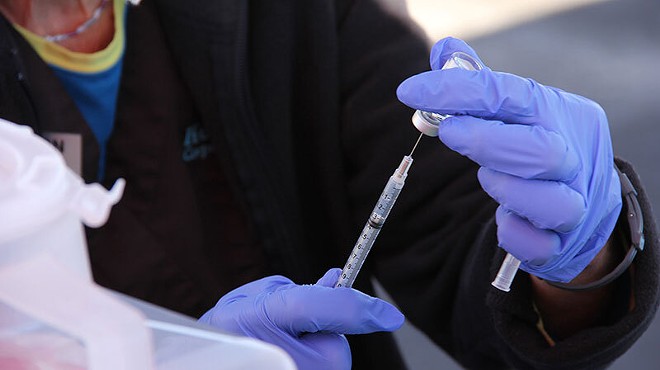Thursday, September 24, 2009
Water on Mars! Can We Pipe It To Tucson?

- NASA/JPL/University of Arizona

- NASA/JPL/University of Arizona
More beautiful photos of Mars from the UA's HiRISE camera aboard the Mars Reconnaissance Orbiter.
The latest news: HIRISE has helped scientists spot ice below the surface of Mars halfway between the north pole and the equator, thanks to photos of craters that had been recently created by meteor collisions.
Lori Stiles of UA News tells us:
Scientists are seeing sub-surface water ice that may be 99 percent pure
halfway between the north pole and the equator on Mars, thanks to
quick-turnaround observations from orbit of fresh meteorite impact
craters on the planet."We knew there was ice below the surface at high latitudes of Mars, but
we find that it extends far closer to the equator than you would think,
based on Mars' climate today," said Shane Byrne of the University of
Arizona, a member of the High Resolution Imaging Science Experiment, or
HiRISE, which runs the high-resolution camera on NASA's Mars
Reconnaissance Orbiter."The other surprising discovery is that ice exposed at the bottom of
these meteorite impact craters is so pure," Byrne said. "The thinking
before was that iceaccumulates below the surface between soil grains,
so there would be a 50-50 mix of dirt and ice. We were able to figure
out, given how long it took that ice to fade from view, that the mixture
is about one percent dirt and 99 percent ice."Scientists used several instruments on the Mars Reconnaissance Orbiter,
or MRO, in quick succession in detecting and confirming highly pure,
bright ice exposed in new craters, ranging from 1.5 feet to 8 feet deep,
at five different Martian sites.In August 2008, the orbiter's Context camera team examined their images
for any dark spots or other changes that weren't visible in earlier
images of the same area. Meteorites usually leave dark marks when they
crash into dust-covered Mars terrain.The HiRISE team, which bases its operations at the UA Lunar and
Planetary Laboratory, followed up in September 2008 by taking
high-resolution images of the dark spots."We saw something very unusual when we followed up on the first of these
impact craters," Byrne said, "and that was this bright blue material
poking up from the bottom of the crater. It looked a lot like water ice.
And sure enough, when we started monitoring this material, it faded away
like you'd expect water ice to fade, because water ice is unstable on
Mars' surface and turns directly into water vapor in the atmosphere."A few days later that September, the orbiter's "CRISM" team used their
Compact Reconnaissance Imaging Spectrometer for Mars and got the
spectral signature of water ice exposed in one of the impact craters,
further clinching the discovery."All of this had to happen very quickly because 200 days after we first
saw the ice, it was gone, it was the color of dirt," Byrne said. "If we
had taken HiRISE images just a few months later, we wouldn't have
noticed anything unusual. This discovery would have just passed us by."Byrne and 17 co-authors are reporting the findings in the Sept. 25
edition of the journal Science.How far water ice extends toward the equator depends largely on how much
water has been available in the Martian atmosphere in the recent past,
Byrne said: "The ice is a relic of a more humid climate not very long
ago, perhaps just several thousand years ago."The Phoenix Mars Lander mission last year also found clean ice at its
landing site on the northern plains of Mars, Byrne noted.But to find highly pure ice far closer to the equator because of random
meteor impacts was unexpected, he said.There are several theories about how a layer of such pure ice could have
formed beneath Mars surface. Byrne said he thinks that one of the most
promising ideas is that this ice on Mars formed in the same way that
pure ice lenses form beneath the surface of the Earth."That's where you have very thin films of liquid water around ice grains
and soil grains and they migrate around to form clear ice lenses on top
of the ice table, even at temperatures well below zero. This process is
called ‘frost heave' on Earth, and it's considered a nuisance in most
places because it cracks up roads and tilts walls and destroys
foundations of houses."But on Mars it would be of great interest if we could discover a
process that involved liquid water in today's climate, and not just in
some of the warmest areas of the planet but in some of the coldest areas
of the planet in the high latitude regions," Byrne said.In the past decade, researchers from UA's Lunar and Planetary Laboratory
have played major roles in piecing together the picture of where water
is to be found on Mars:* Professor Alfred McEwen, a co-author on the Sept. 25 Science paper, is
principal investigator for HiRISE, which began imaging Mars in November
2006. At this time, the HiRISE Web site features more than 577processed
pictures of Martian water features among thousands of pictures of
features on the surface of the planet.* Professor William Boynton developed the Gamma Ray Spectrometer
instrument package on Mars Odyssey that detected water ice near the
Martian poles in 2001.* Phoenix Mars Lander principal investigator Peter Smith headed the
mission that used a long robotic arm to uncover and confirm the shallow
ice table at its landing site, and other instruments to document
snowfall and ground frost at its high polar latitude. The Phoenix Mars
Mission began science operations on the northern plains of Mars after
landing May 25, 2008, and lasted five months, until winter arrived.
The Mars Reconnaissance Orbiter is managed by the Jet Propulsion
Laboratory, a division of the California Institute of Technology, for
NASA's Science Mission Directorate in Washington.The University of Arizona operates the High Resolution Imaging Science
Experiment, which operates the HiRISE camera built by Ball Aerospace &
Technologies Corp., Boulder, Colo.Lockheed Martin Space Systems, Denver, built the spacecraft. The Context
Camera is operated by and was provided by Malin Space Science Systems.
The Johns Hopkins University Applied Physics Laboratory led the effort
to build the Compact Reconnaissance Imaging Spectrometer for Mars and
operates it in coordination with an international team of researchers.















